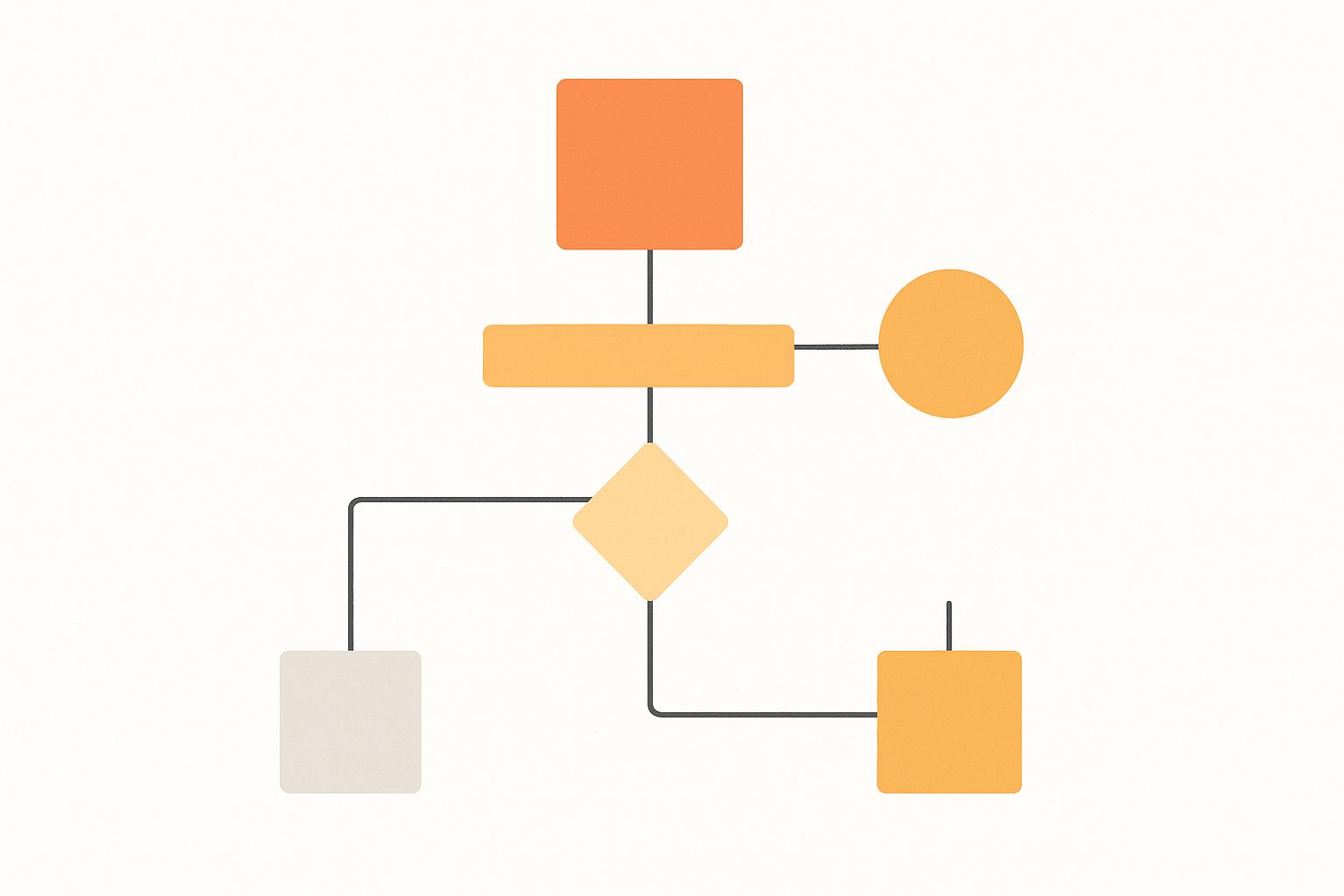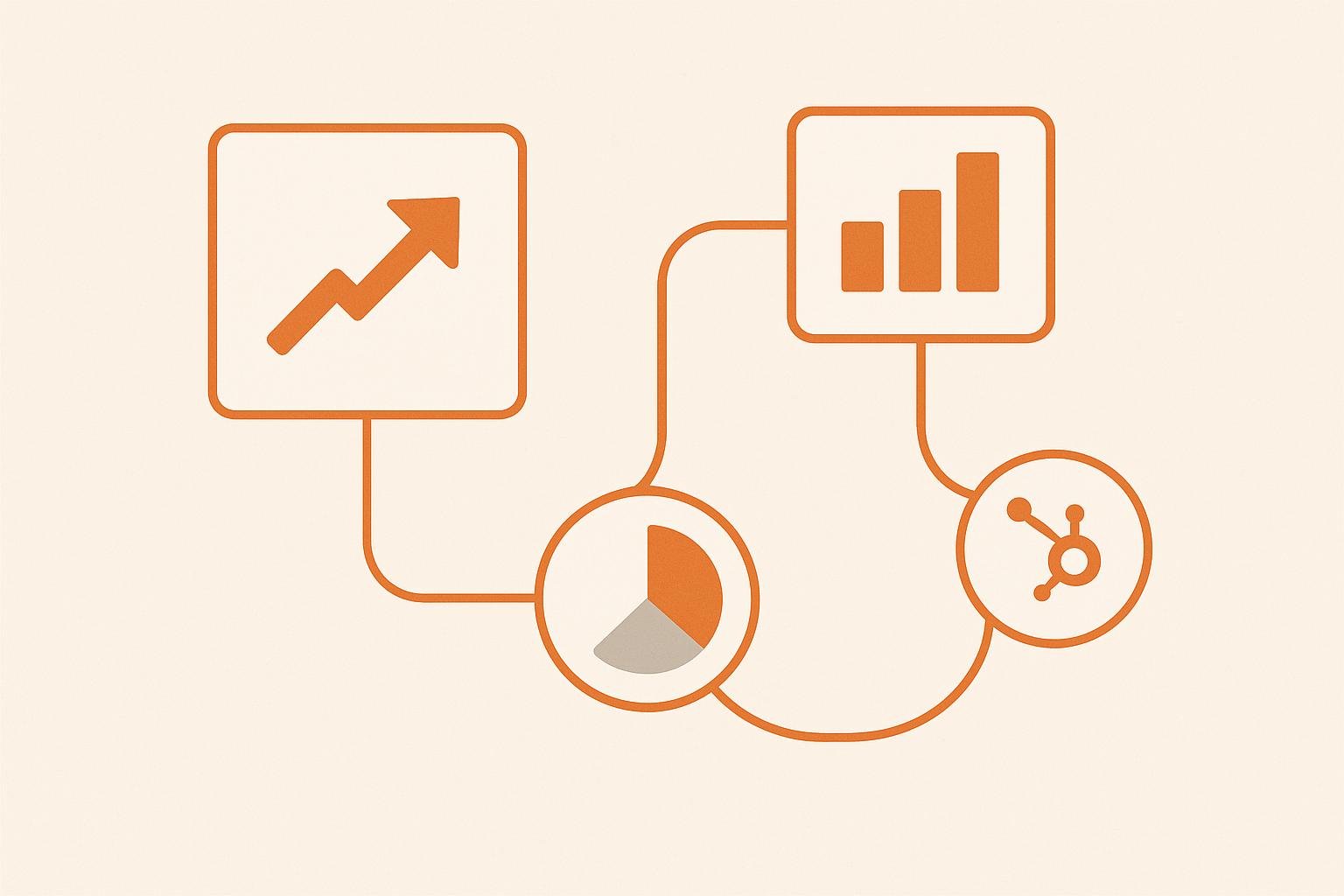Ultimate Guide to HubSpot Sales Pipeline Automation
Automating your sales pipeline with HubSpot can save time, reduce errors, and increase revenue. Instead of managing repetitive tasks manually, HubSpot's tools handle workflows like lead assignments, deal stage updates, and follow-up emails automatically.
Key Benefits:
- Save Time: Automate tasks like data entry and follow-ups.
- Increase Accuracy: Reduce human errors in deal tracking.
- Boost Revenue: 75% of HubSpot users report higher revenue after adopting automation.
- Improve Team Collaboration: Align sales, marketing, and operations for seamless workflows.
Quick Overview of HubSpot Tools:

- Workflows: Automate repetitive processes.
- AI Features: Predict deal outcomes and suggest next steps.
- Integrations: Connect HubSpot with other tools for better data flow.
By setting up clear pipeline stages, defining deal properties, and automating tasks, you can simplify your sales process and focus on closing deals. Ready to make your sales pipeline more efficient? Let’s dive in.
How To Set Up Deals In HubSpot With Pipeline Automation
HubSpot Pipeline Setup Guide
Setting up your sales pipeline in HubSpot the right way is essential for automation success. A properly structured pipeline ensures accurate tracking, reliable reporting, and scalability. Follow these steps to get your pipeline set up and running smoothly.
Setting Up Pipeline Stages
Your pipeline stages should align with your actual sales process. Start by mapping out your sales workflow before diving into HubSpot:
- Review Your Sales Process: Break down each stage and decision point in your workflow.
- Define Exit Criteria: Clearly outline what needs to happen before a deal moves to the next stage.
- Set Probabilities: Assign realistic probability percentages to each stage to improve forecasting.
Once your stages are defined, you’ll be ready to set up deal properties to keep everything running efficiently.
Deal Properties Setup
Deal properties are the backbone of your pipeline. Focus on creating fields that capture only the data you truly need.
| Property Type | Purpose | Example Fields |
|---|---|---|
| Required Fields | Key deal details | Deal value, close date, decision-maker |
| Automated Fields | System-generated updates | Last activity date, days in stage |
| Custom Fields | Business-specific insights | Industry vertical, product interest |
Pro Tips:
- Use dropdowns or radio buttons to standardize inputs.
- Set up property dependencies to guide logical data entry.
- Enable field validation to minimize errors.
Well-structured properties help streamline automation and keep your pipeline data clean.
Pipeline Organization Tips
- Segment Deals: Use tags or custom properties to group deals by source, type, or business segment.
- Regular Maintenance: Schedule weekly reviews, monthly audits, and quarterly data checks to keep your pipeline in top shape.
- Control Access: Set user permissions to protect sensitive information while ensuring team members can access what they need.
An organized pipeline makes automation easier and helps your team work more effectively.
Deal Stage Movement Automation
HubSpot simplifies deal management by automating stage updates through workflows. These workflows kick in based on specific conditions, ensuring your CRM stays up-to-date and your team stays aligned. By setting well-defined triggers that match your sales process, you can keep deal updates accurate and operations running smoothly.
It's also important to revisit and tweak these workflow rules regularly to make sure they align with any changes in your sales strategy.
Up next, explore how to automate task assignments and follow-ups to keep your pipeline running efficiently.
sbb-itb-14d4def
Pipeline Task Automation
After automating deal stages, streamlining routine tasks can take your pipeline's efficiency to the next level. HubSpot makes it easier to save time and improve sales performance by automating these tasks.
Automating Follow-Up Emails
One of the most effective ways to automate pipeline tasks is through follow-up emails. With HubSpot's Sequence tool, you can set up automated emails triggered by deal stages or specific actions taken by prospects. This ensures consistent communication while allowing your team to focus on more critical tasks.
From here, you can explore other ways to optimize your pipeline with task automation.
Advanced Automation Methods
Streamline your HubSpot pipeline automation by combining marketing and sales processes, creating custom workflows, and leveraging API integrations.
Connecting Marketing and Sales Automation
Use lead scoring automation to initiate targeted actions for your sales team. For instance, when prospects interact with multiple marketing assets, automated workflows can:
- Update deal stages based on engagement levels
- Launch personalized sales outreach campaigns
- Assign leads to specific sales reps
- Schedule follow-up tasks tailored to interaction trends
Tip: Define clear scoring thresholds that match your sales qualification criteria. This ensures a smooth handoff from marketing qualified leads (MQLs) to sales qualified leads (SQLs) without requiring manual steps.
Using Custom Code in Workflows
Take automation to the next level by incorporating custom code for more complex scenarios. JavaScript can be used within workflows to handle advanced logic.
Example:
const dealValue = parseFloat(properties.deal_value);
const probability = parseFloat(properties.probability);
const weightedValue = dealValue * (probability / 100);
return weightedValue;
This script calculates weighted deal values based on probability, allowing you to automate pipeline actions or send notifications based on these values.
HubSpot API Integration Overview
HubSpot's API offers powerful options for system integration. These integrations can help you:
1. Sync Data Automatically
Enable two-way data sharing between HubSpot and other platforms.
2. Create Custom Triggers
Set up unique automation triggers based on external events or data points outside of HubSpot's native workflows.
3. Improve Reporting
Combine HubSpot data with external tools to produce detailed pipeline analytics.
| API Integration Type | Use Case | Benefit |
|---|---|---|
| Webhook Integration | Real-time deal updates | Immediate pipeline adjustments |
| Batch Processing | Bulk data synchronization | Higher data accuracy |
| Custom Objects API | Expanded data models | Enhanced deal insights |
When applying these advanced automation techniques, align them with your business goals. Focus on building processes that foster collaboration between teams and ensure every customer interaction is informed by data and purpose-driven.
Summary and Next Steps
Main Automation Benefits
Research shows that using HubSpot automation can help boost revenue growth [1]. Here’s a quick look at the key benefits:
| Benefit Area | Impact |
|---|---|
| Revenue Growth | Better lead conversion and faster deal closure |
| Team Efficiency | Fewer manual tasks and less data entry |
| Data Quality | More accurate reports and forecasts |
| Customer Experience | Personalized and timely interactions |
| Cross-team Alignment | Seamless collaboration across teams |
These advantages set the stage for the next steps in implementation.
Implementation Steps
Follow these steps to kickstart your automation efforts:
-
Conduct a HubSpot Audit
Review your current processes to identify areas where automation can make an impact. Pay attention to data accuracy, workflow efficiency, and your team's capabilities. -
Develop an Implementation Strategy
Create a phased plan that prioritizes critical areas, such as:- Triggers for deal stage movements
- Task assignment workflows
- Follow-up email sequences
- Lead scoring setup
-
Execute and Monitor
Roll out automation workflows step by step. Keep an eye on performance metrics and adjust based on results and team input.
OT:OT Services Overview

OT:OT helps you make the most of HubSpot with these services:
- Revenue Architecture Sprints: Coordinate sales, marketing, and operations to drive consistent revenue growth.
- Custom Data Modeling: Adapt HubSpot’s framework to fit your business processes.
- Team Enablement: Offer targeted training to ensure your team uses automation effectively.


